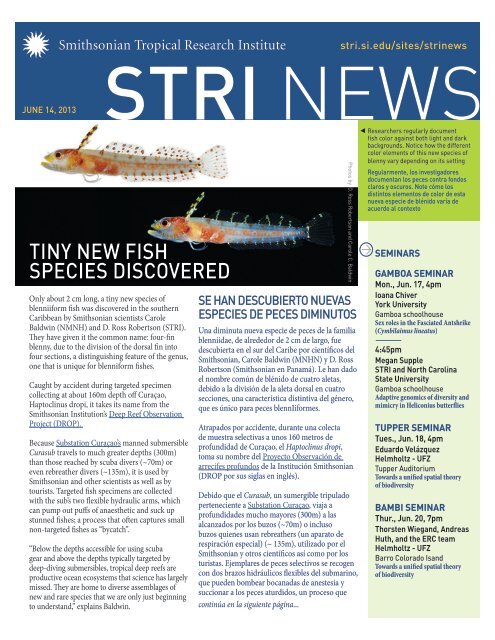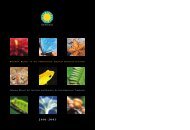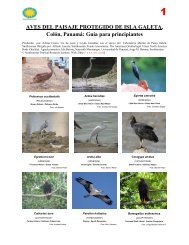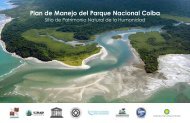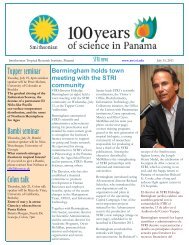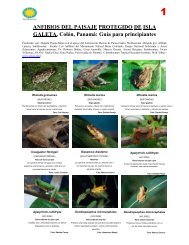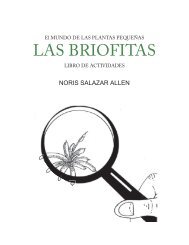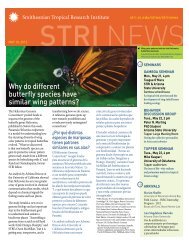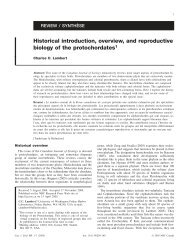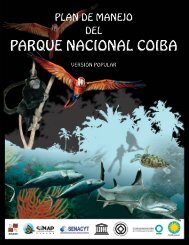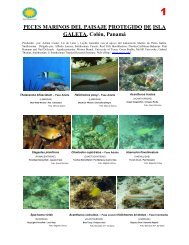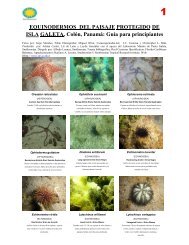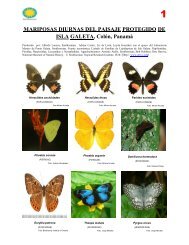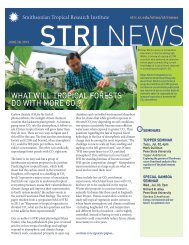tiny new fish species discovered - Smithsonian Tropical Research ...
tiny new fish species discovered - Smithsonian Tropical Research ...
tiny new fish species discovered - Smithsonian Tropical Research ...
Create successful ePaper yourself
Turn your PDF publications into a flip-book with our unique Google optimized e-Paper software.
JUNE 14, 2013<br />
stri.si.edu/sites/stri<strong>new</strong>s<br />
STRI NEWS<br />
TINY NEW FISH<br />
SPECIES DISCOVERED<br />
Only about 2 cm long, a <strong>tiny</strong> <strong>new</strong> <strong>species</strong> of<br />
blenniiform <strong>fish</strong> was <strong>discovered</strong> in the southern<br />
Caribbean by <strong>Smithsonian</strong> scientists Carole<br />
Baldwin (NMNH) and D. Ross Robertson (STRI).<br />
They have given it the common name: four-fin<br />
blenny, due to the division of the dorsal fin into<br />
four sections, a distinguishing feature of the genus,<br />
one that is unique for blenniform <strong>fish</strong>es.<br />
Caught by accident during targeted specimen<br />
collecting at about 160m depth off Curaçao,<br />
Haptoclinus dropi, it takes its name from the<br />
<strong>Smithsonian</strong> Institution’s Deep Reef Observation<br />
Project (DROP).<br />
Because Substation Curaçao’s manned submersible<br />
Curasub travels to much greater depths (300m)<br />
than those reached by scuba divers (~70m) or<br />
even rebreather divers (~135m), it is used by<br />
<strong>Smithsonian</strong> and other scientists as well as by<br />
tourists. Targeted <strong>fish</strong> specimens are collected<br />
with the sub’s two flexible hydraulic arms, which<br />
can pump out puffs of anaesthetic and suck up<br />
stunned <strong>fish</strong>es; a process that often captures small<br />
non-targeted <strong>fish</strong>es as “bycatch”.<br />
“Below the depths accessible for using scuba<br />
gear and above the depths typically targeted by<br />
deep-diving submersibles, tropical deep reefs are<br />
productive ocean ecosystems that science has largely<br />
missed. They are home to diverse assemblages of<br />
<strong>new</strong> and rare <strong>species</strong> that we are only just beginning<br />
to understand,” explains Baldwin.<br />
SE HAN DESCUBIERTO NUEVAS<br />
ESPECIES DE PECES DIMINUTOS<br />
Una diminuta nueva especie de peces de la familia<br />
blenniidae, de alrededor de 2 cm de largo, fue<br />
descubierta en el sur del Caribe por científicos del<br />
<strong>Smithsonian</strong>, Carole Baldwin (MNHN) y D. Ross<br />
Robertson (<strong>Smithsonian</strong> en Panamá). Le han dado<br />
el nombre común de blénido de cuatro aletas,<br />
debido a la división de la aleta dorsal en cuatro<br />
secciones, una característica distintiva del género,<br />
que es único para peces blennIiformes.<br />
Atrapados por accidente, durante una colecta<br />
de muestra selectivas a unos 160 metros de<br />
profundidad de Curaçao, el Haptoclinus dropi,<br />
toma su nombre del Proyecto Observación de<br />
arrecifes profundos de la Institución <strong>Smithsonian</strong><br />
(DROP por sus siglas en inglés).<br />
Debido que el Curasub, un sumergible tripulado<br />
perteneciente a Substation Curaçao, viaja a<br />
profundidades mucho mayores (300m) a las<br />
alcanzados por los buzos (~70m) o incluso<br />
buzos quienes usan rebreathers (un aparato de<br />
respiración especial) (~ 135m), utilizado por el<br />
<strong>Smithsonian</strong> y otros científicos así como por los<br />
turistas. Ejemplares de peces selectivos se recogen<br />
con dos brazos hidráulicos flexibles del submarino,<br />
que pueden bombear bocanadas de anestesia y<br />
succionar a los peces aturdidos, un proceso que<br />
continúa en la siguiente página...<br />
Photos by D. Ross Robertson and Carole C. Baldwin<br />
<strong>Research</strong>ers regularly document<br />
<strong>fish</strong> color against both light and dark<br />
backgrounds. Notice how the different<br />
color elements of this <strong>new</strong> <strong>species</strong> of<br />
blenny vary depending on its setting<br />
Regularmente, los investigadores<br />
documentan los peces contra fondos<br />
claros y oscuros. Note cómo los<br />
distintos elementos de color de esta<br />
nueva especie de blénido varía de<br />
acuerdo al contexto<br />
SEMINARS<br />
GAMBOA SEMINAR<br />
Mon., Jun. 17, 4pm<br />
Ioana Chiver<br />
York University<br />
Gamboa schoolhouse<br />
Sex roles in the Fasciated Antshrike<br />
(Cymbilaimus lineatus)<br />
4:45pm<br />
Megan Supple<br />
STRI and North Carolina<br />
State University<br />
Gamboa schoolhouse<br />
Adaptive genomics of diversity and<br />
mimicry in Heliconius butterflies<br />
TUPPER SEMINAR<br />
Tues., Jun. 18, 4pm<br />
Eduardo Velázquez<br />
Helmholtz - UFZ<br />
Tupper Auditorium<br />
Towards a unified spatial theory<br />
of biodiversity<br />
BAMBI SEMINAR<br />
Thur., Jun. 20, 7pm<br />
Thorsten Wiegand, Andreas<br />
Huth, and the ERC team<br />
Helmholtz - UFZ<br />
Barro Colorado Isand<br />
Towards a unified spatial theory<br />
of biodiversity
de la página anterior...<br />
a menudo captura pequeños peces que no son<br />
objetivo como “captura incidental.”<br />
“Por debajo de las profundidades accesibles<br />
utilizando equipo de buceo y por encima de<br />
las profundidades normalmente dirigidas<br />
por los sumergibles de inmersión profunda,<br />
los arrecifes profundos tropicales son<br />
ecosistemas marinos productivos que la<br />
ciencia ha pasado por alto en gran medida.<br />
Estos son el hogar de diversos conjuntos de<br />
e<strong>species</strong> nuevas y poco comunes que apenas<br />
estamos comenzando a entender,” explica<br />
Baldwin.<br />
Baldwin CC, Robertson RD (2013) A <strong>new</strong> Haptoclinus<br />
blenny (Teleostei, Labrisomidae) from deep reefs off Curacao,<br />
southern Caribbean, with comments on relationships of the<br />
genus. ZooKeys 306: 71–81, doi: 10.3897/zookeys.306.5198<br />
Photo by Barry Brown, Substation Curacao<br />
Substation Curaçao’s<br />
manned submersible<br />
Curasub was used<br />
to catch specimens<br />
for the <strong>Smithsonian</strong><br />
Institution’s Deep<br />
Reef Observation<br />
Project (DROP)<br />
El sumergible<br />
tripulado Curasub<br />
perteneciente a<br />
Substation Curaçao<br />
se utilizó para<br />
capturar especímenes<br />
para el Proyecto<br />
de Observación de<br />
arrecifes profundos<br />
de la Institución<br />
<strong>Smithsonian</strong> (DROP<br />
por sus siglas en<br />
inglés).<br />
Guna leader Evelio Jiménez, STRI fellow Javier<br />
Mateo, STRI research technician José Monteza<br />
and STRI associate scientist Catherine Potvin (L-R)<br />
discuss a forest carbon measuring expedition in<br />
Diwarsicua, Panama on Monday, April 29, 2013. The<br />
team estimated carbon stocks for comparison with<br />
a LiDAR carbon map made by STRI and the Carnegie<br />
Airborne Observatory in 2012<br />
Evelio Jiménez, líder Guna, Javier Mateo, becario del<br />
<strong>Smithsonian</strong>, José Monteza, técnico en investigación<br />
del <strong>Smithsonian</strong> y Catherine Potvin, científica<br />
asociada del <strong>Smithsonian</strong> (izq. a der.) conversan<br />
sobre una expedición de medición del carbono<br />
forestal en Diwarsicua , Panamá, el Lunes, 29<br />
de abril 2013 . El equipo hizo un estimado de las<br />
reservas de carbono para compararlo con un mapa<br />
de carbono LiDAR hecho por el <strong>Smithsonian</strong> y el<br />
Observatorio Aéreo Carnegie en el 2012<br />
WHO OWNS THE CARBON?<br />
Evelio Jiménez pilots a canoe through the Guna territory of<br />
Madugandí in eastern Panama. The buzz of chainsaws fills the air<br />
and timber is stacked on the riverbank. Once the water rises with<br />
the rainy season, the lumber will be ferried out. It might appear<br />
like another all-too-common scene of deforestation in Panama’s<br />
Darién but Evelio says he’s not worried. Commercial loggers will<br />
no longer be allowed to operate in the 230,000-hectare territory<br />
by 2014, the Guna leader says. He has already moved past timber,<br />
anyway. Carbon is his concern.<br />
On this May expedition in the comarca, Evelio is leading a team<br />
of <strong>Smithsonian</strong> scientists and indigenous technicians who will<br />
measure the carbon stores across 30 hectares. The research will<br />
generate on-the-ground carbon estimates that will be compared<br />
with a carbon map created by STRI and the Carnegie Airborne<br />
Observatory. Using Light Detection and Ranging (LiDAR)<br />
technology, the map is considered the most precise nation-level<br />
inventory of carbon stocks to date. But Evelio won’t trust the<br />
results until he and colleagues gather ground data and compare.<br />
Photos by Sean Mattson<br />
“For (the Guna) to believe the result from this plane is just<br />
like an act of faith that they are not necessarily ready to do,”<br />
explains Catherine, who is an intermediary between high-end<br />
technology and the indigenous understanding of the forested<br />
landscape. Catherine’s lab, which researches the relationship<br />
between carbon stocks and biodiversity in Panama, melds study<br />
of natural environment with the societies of the people who live<br />
there. Through two decades of working in Panama’s indigenous<br />
communities, the approach - which her students call “Science for<br />
Empowerment” - seems to be working. After initial guidance and<br />
training, locals maintain long-term conservation science projects.<br />
“This is very important because if this territory wants to engage in<br />
a carbon market, for climate change, like payment for ecosystem<br />
services ... they need to be able to measure carbon, estimate the<br />
carbon, monitor the carbon,” says Catherine. Evelio agrees. If<br />
the indigenous leaders decide to enter a carbon market, they will<br />
be ready. The Gunas will “have knowledge of how many tons of<br />
carbon there are in Madugandí,” he says, proudly.
STRI associate scientist and McGill University professor Catherin Potvin discusses<br />
how to measure a 1-hectare plot for carbon measurement in the forests of the Guna<br />
indigenous territory of Madugandí, Panama during a recent expedition<br />
Catherine Potvin, científica asociada del <strong>Smithsonian</strong> en Panamá y profesora en la<br />
Universidad de McGill conversa durante una reciente expedición sobre cómo medir<br />
una parcela de 1 hectárea para la medición de carbono en los bosques del territorio<br />
indígena Guna de Madugandí, Panamá<br />
¿A QUIÉN PERTENECE EL CARBONO?<br />
Evelio Jiménez maniobra una canoa a través del territorio Guna de<br />
Madugandí al este de Panamá. La madera se apila en la orilla del río<br />
y se escuchan las motosierras a lo lejos. Una vez que el agua se eleva<br />
con la temporada lluviosa, la madera se transporta por agua. Podría<br />
parecer como otra escena muy común de la deforestación en el este<br />
de Panamá, pero Evelio dice que no está preocupado. Para el 2014,<br />
los madereros comerciales ya no podrán operar en el territorio<br />
de 230.000 hectáreas según el líder Guna. Él ya se ha alejado de la<br />
madera, de todos modos. El carbono es lo que le atañe.<br />
El pasado mes de mayo, durante una expedición en la comarca que<br />
formaba parte de un proyecto en curso financiado por la Fundación<br />
Margaret A. Cargill y la Universidad McGill, Evelio dirigió a un<br />
equipo de científicos del <strong>Smithsonian</strong> y técnicos indígenas que<br />
utilizarán los datos recopilados para medir los depósitos de carbono<br />
a través del territorio. La investigación generará estimaciones de<br />
carbono en el terreno que se compararán con un mapa de carbono<br />
creado por el <strong>Smithsonian</strong> en Panamá y el Observatorio Aéreo<br />
Carnegie. El mapa, que utiliza la tecnología de medición aérea<br />
LiDAR, se considera el inventario de las reservas de carbono a nivel<br />
de nación más precisa hasta la fecha. Pero Evelio y su comunidad<br />
no creerán estos resultados hasta que él y sus colegas reúnan datos<br />
sobre el terreno y los comparen.<br />
“Para (los Guna) creer en los resultados proporcionados por este<br />
planeador es como un acto de fe que no están necesariamente<br />
dispuestos a hacer,” explica Catherine Potvin, profesora de McGill y<br />
científica asociada del <strong>Smithsonian</strong> quien es intermediario entre la<br />
alta tecnología y el entendimiento del paisaje boscoso de los pueblos<br />
indígenas. El equipo de laboratorio de Catherine, que investiga la<br />
relación entre las reservas de carbono y la biodiversidad en Panamá,<br />
combina el estudio del ambiente natural con las sociedades de las<br />
personas que viven allí. A través de dos décadas de trabajo en las<br />
comunidades indígenas de Panamá, el enfoque, que sus alumnos<br />
llaman “Ciencia para Poder,” parece estar funcionando. Después<br />
de la orientación y la formación inicial, los locales mantienen<br />
proyectos científicos de conservación a largo plazo.<br />
Guna technician Alexis Solis (top) uses a woody vine to reach the trunk of a tree<br />
above its buttress roots to measure its diameter | Fellow technicians Edgar<br />
Garibaldo (bottom left) and Abel Oller (bottom right) measure tree diameter in<br />
the indigenous territory of Madugandí<br />
Alexis Solis, técnico Guna (arriba) utiliza una enredadera leñosa para alcanzar el<br />
tronco de un árbol por encima de sus raíces de soporte para medir su diámetro |<br />
Técnicos compañeros Edgar Garibaldo (parte inferior izquierda) y Abel Oller (abajo<br />
a la derecha) miden el diámetro del árbol en el territorio indígena de Madugandí<br />
“Esto es muy importante porque si los Gunas quieren participar en<br />
un mercado de carbono, para el cambio climático, como el pago por<br />
servicios de los ecosistemas... tienen que ser capaces de medir el<br />
carbono, hacer estimados de ese carbono, monitorear el carbono,”<br />
comenta Catherine. Evelio está de acuerdo. Si los líderes indígenas<br />
deciden entrar en un mercado de carbono, ellos estarán listos. Los<br />
Gunas “tendrán conocimiento de cuántas toneladas de carbono hay<br />
en Madugandí, “ dice Evelio orgullosamente.
THE RAINMAKER<br />
VISITS AGUA<br />
SALUD<br />
In central Panama, rain falls in<br />
prodigious volumes on clay soils.<br />
When H2O overload happens,<br />
water may form a sheet that<br />
races down a slope. This was<br />
thought to happen regularly<br />
on forested land in the rainy<br />
tropics. However, a rainmaking<br />
experiment in the Panama Canal<br />
Watershed, showed hydrologist<br />
Fred Ogden that overland flow<br />
might not be as common as once<br />
believed.<br />
Fred and his team used a spiderlike<br />
aluminum contraption of<br />
pipes and sprinklers to simulate<br />
rainfall on different landscapes.<br />
The result on pastureland was<br />
surprising: the percentage of<br />
overland flow did not change<br />
much with rainfall. Recently<br />
reforested land behaved similarly.<br />
When Fred moved his computercontrolled<br />
rainmaker to older<br />
forest, he couldn’t make the water<br />
flow over the surface - even by<br />
dumping 50 cm (20 inches) of<br />
rain in three hours.<br />
“It’s a very tantalizing result,”<br />
says Fred, a senior STRI research<br />
associate and engineering<br />
professor at the University of<br />
Wyoming. “It supports the idea<br />
that land-use modifications,<br />
because they cause biological<br />
changes in the soil, have a huge<br />
effect on the hydrologic behavior<br />
of the soil.”<br />
Photo by Jorge Alemán<br />
EL HACEDOR DE<br />
LLUVIA VISITA<br />
AGUA SALUD<br />
En provincias centrales, la lluvia<br />
cae en abundantes volúmenes<br />
sobre suelos arcillosos. Cuando<br />
se produce una sobrecarga de<br />
H2O, el agua puede formar una<br />
lámina que se desliza por una<br />
pendiente. Se pensaba que esto<br />
sucede regularmente en tierras<br />
forestales en el trópico lluvioso.<br />
Sin embargo, un experimento<br />
simulador de lluvia en la Cuenca<br />
del Canal de Panamá, mostró<br />
al hidrólogo Fred Ogden que el<br />
flujo superficial puede que no<br />
sea tan común como se creía<br />
anteriormente .<br />
Fred y su equipo utilizaron<br />
un artefacto con tuberías y<br />
rociadores de aluminio en<br />
forma de araña para simular la<br />
lluvia en diferentes paisajes. El<br />
resultado en tierras de pastoreo<br />
fue sorprendente: el porcentaje<br />
de flujo superficial no cambió<br />
mucho con la lluvia. En áreas<br />
donde recientemente el terreno<br />
fue reforestado se comportó de<br />
manera similar. Cuando Fred<br />
trasladó su aparato simulador<br />
de lluvia controlado por<br />
computadora hacia bosques<br />
más viejos, no pudo hacer que el<br />
agua fluyera sobre la superficie<br />
- incluso al descargar 50 cm (20<br />
pulgadas) de lluvia en tres horas.<br />
“Es un resultado muy<br />
provocador,” comenta Fred,<br />
investigador sénior asociado<br />
del <strong>Smithsonian</strong> en Panamá<br />
y profesor de ingeniería en<br />
la Universidad de Wyoming.<br />
“Esto apoya la idea de que las<br />
modificaciones de uso de la<br />
tierra, debido a que causan<br />
cambios biológicos en el suelo,<br />
tienen un gran efecto sobre el<br />
comportamiento hidrológico del<br />
mismo.”
ARRIVALS<br />
DEPARTURES<br />
PUBLICATIONS<br />
Toby Thorne<br />
Western University<br />
Bat-Eating Bats<br />
Gamboa and Barro Colorado<br />
Island<br />
Justin Lawrence<br />
University of Mississippi<br />
Correlations of coloration and<br />
toxicity to diet specialization in<br />
dendrobatid frogs using illumina<br />
techniques<br />
Bocas del Toro<br />
Douglas Hooton<br />
University of California -<br />
Los Angeles<br />
Dimensions: Testing the potential<br />
of pathogenic fungi to control<br />
the diversity, distribution, and<br />
abundance of tree <strong>species</strong> in a<br />
Neotropical forest community<br />
Barro Colorado Island<br />
Joseph Luczkovich, Nicole<br />
Corbett and Jillon McGreal<br />
East Carolina University<br />
Field Course - Marine Field Ecology/<br />
Carolina East University 2013<br />
Bocas del Toro, Galeta Station<br />
and Barro Colorado Island<br />
Eduardo Velázquez<br />
Helmholtz Center for<br />
Environmental <strong>Research</strong> – UFZ<br />
Exploratory visits<br />
Tupper and Barro Colorado<br />
Island<br />
Héctor Guzmán<br />
To Bocas del Toro<br />
Monitoring System for Manatees in<br />
the Sixaola River Watershed.<br />
Máximo Jimenez and<br />
Aureliano Valencia<br />
To Isla Casaya, Archipiélago<br />
de las Perlas<br />
Fishes sampling for the Arqueological<br />
Lab in Naos collection<br />
You are cordially invited to the<br />
NEO Symposium<br />
(Neotropical Environment Option)<br />
Friday July 5 th , 2013<br />
9 a.m. - 5 p.m.<br />
Redpath Museum,<br />
859 Sherbrooke Street West<br />
Please RSVP by Wednesday June 19 th , 2013, NOON to:<br />
martine.dolmiere@mcgill.ca<br />
Craven, D., Hall, J. S., Ashton, M.<br />
S. and Berlyn, G. P. 2013. Wateruse<br />
efficiency and whole-plant<br />
performance of nine tropical tree<br />
<strong>species</strong> at two sites with contrasting<br />
water availability in Panama. Trees,<br />
27: 639-653. doi:10.1007/s00468-<br />
012-0818-0<br />
Taylor, R. C. and Ryan, M. J. 2013.<br />
Interactions of Multisensory<br />
Components Perceptually<br />
Rescue Túngara Frog Mating<br />
Signals. Science, doi:10.1126/<br />
science.1237113<br />
Cernusak, L. A., Winter, K.,<br />
Dalling, J. W., Holtum, J. A.,<br />
Jaramillo, C. A., Korner, C., Leakey,<br />
A. A., Norby, R. J., Poulter, B.,<br />
Turner, B. L. and Wright, S. J.<br />
2013. <strong>Tropical</strong> forest responses<br />
to increasing atmospheric<br />
CO2: current knowledge and<br />
opportunities for future research.<br />
Functional Plant Biology, 81(2):<br />
465-472. doi:10.1071/FP12309<br />
GAMBOA COFFEEHOUSE<br />
POTLUCK<br />
FOOD AND DRINK<br />
SATURDAY<br />
JUNE 15<br />
Come play frisbee, soccer and<br />
football before the potluck on the<br />
fields nearby<br />
6:00 pm Potluck starts at the<br />
Gamboa Civic Center<br />
(next to the schoolhouse)<br />
There will be an open microphone and a<br />
keyboard for performing music, drama,<br />
poetry, performance art, dance, comedy<br />
and story telling. Gamboa residents, STRI<br />
researchers, and guests of all ages are<br />
welcome to attend and perform. Pianos,<br />
guitars, flute and various percussion<br />
instruments will be available.<br />
Sarah Bouchard<br />
Otterbein College<br />
Fear, death and life history<br />
switch points: cumulative effects<br />
of phenotypic plasticity and<br />
predation across three life stages<br />
Gamboa<br />
Rachel Perez<br />
New Mexico Tech<br />
Rays of hope: Identifying<br />
factors mediating the survival of<br />
Panamanian Atelopus populations<br />
Panama<br />
Thomas Hiller and<br />
Marco Tschapka<br />
University of Ulm<br />
Ecology and <strong>species</strong> barriers<br />
in emerging viral diseases<br />
Barro Colorado Island<br />
Sponsored by the <strong>Smithsonian</strong> <strong>Tropical</strong> <strong>Research</strong> Institute,<br />
NEO, the Faculty of Science<br />
Please bring your own potluckstyle<br />
food and drink!<br />
Questions/comments<br />
Preguntas/comentarios<br />
STRINews@si.edu


